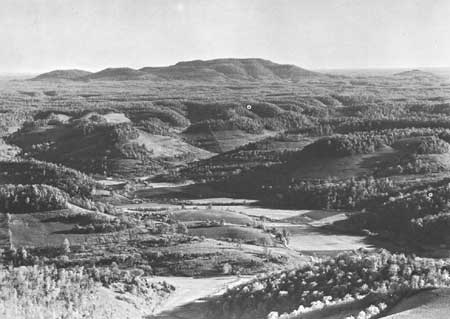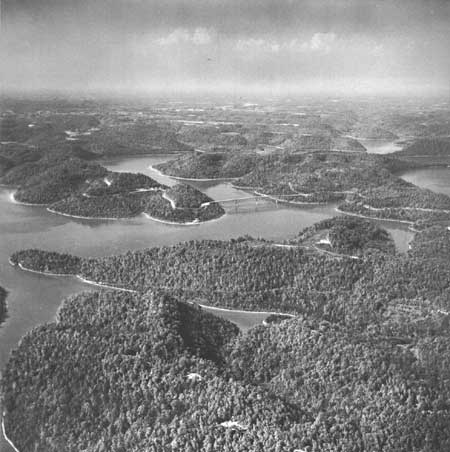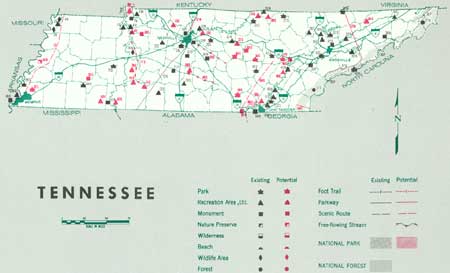.gif)
Parks for America
MENU
|
Parks for America
|

|

|
| Short Mountain, a potential State park area in Tennessee. (TENNESSEE CONSERVATION DEPARTMENT.) |
TENNESSEE
LYING between the Great Smoky Mountains and the Mississippi River, Tennessee is rich in historical heritage and natural resources and an abundance of water stored in manmade reservoirs.
The population increased 8 percent during the 1950-60 decade to 3,567,089. The increase occurred in urban areas, which showed a 28-percent increase, while the rural population decreased 7 percent. The average density was 85 persons per square mile. Projections indicate a population of 3,943,000 by 1976.
Tourism, with an estimated expenditure of $155 million in 1960, ranked third in importance to the State's economy.
The forested Cumberland Plateau and Great Smoky Mountains, the Cumberland and Tennessee Rivers, and the large reservoirs are major recreation resources. Fishing in the reservoirs is nationally famous. Free-flowing streams offer a little-used recreation resource.
The State has a long outdoor season marked by summer heat spells but enhanced by the invigorating climate of the Cumberland Plateau and Great Smoky Mountains.
Tennessee is rich in prehistoric Indian sites and historic sites dating from before the Revolutionary War through the Civil War period. In addition to sites in the National Park System, four sites possess exceptional value in commemorating the history of the United States.
EXISTING PUBLIC AREAS
NATIONAL: One national park, three national military parks, one national battlefield, two national historical parks, one national historic site, and two parkways are administered by the National Park Service. They contain 258,554 acres and had an attendance of 10,477,800 in 1960. The Forest Service administers 1 national forest of 594,770 acres, which has 72 recreational areas totaling 492 acres. The 1960 attendance figure for the forest was 2,230,300. The Bureau of Sport Fisheries and Wildlife administers 61,761 acres in 3 national wildlife refuges that had an attendance of 206,936 in 1960. The Corps of Engineers operates 5 reservoirs (2 partly in Kentucky) that have a total of 194 access points. The 1960 attendance was 6,008,000. The Tennessee Valley Authority administers 18 reservoirs (4 partly in adjacent States), with water surface of 412,955 acres, which have 191 public access points. The 1960 attendance was 25,292,543. The six major reservoirs for recreation are included in the tabulation.
STATE: The Division of State Parks administers 21 parks with a total of 80,701 acres; 1960 attendance was 3,859,624. The Division of Forestry has 14 state forests totaling 155,752 acres. The State Game and Fish Commission administers 22 areas, totaling 630,000 acres. The Tennessee Department of Highways has 1,162 roadside parks.
LOCAL: There are five nonurban parks serving Knoxville, totaling 916 acres; two parks serving Nashville, totaling 2,637 acres; and one park of 223 acres serving Chattanooga.
QUASI-PUBLIC AND PRIVATE: There are six historic monuments totaling 3,060 acres, and 48 miles of the Appalachian Trail.
PRIVATE ENTERPRISE: A significant role is played by private enterprise adjacent to Great Smoky Mountain National Park and near major reservoirs.
PARK AND RELATED NEEDS
Free-flowing streams in natural areas, caves, and historical and archeological sites are valuable resources needing further attention. The State park system is reasonably well balanced and distributed, but there is need for additional reservations to protect natural areas and provide recreation near urban centers. There is need for designation and protection of scenic roads.
Existing State recreation areas now provide 80,701 acres for 3,567,029 residents; local areas, an additional 3,453 acres. Potential areas identified in this plan total 79,415 acres judged of State significance and 1,134 of local significance. Assuming that all the identified potential areas are established and developed, there will still be a need by 1976 for additional areas, particularly ones to serve the day-to-day needs of urban dwellers.

|
| Center Hill Reservoir offers recreation potential for Tennessee. (DAVID MURRIAN, TENNESSEE GAME & FISH COMMISSION.) |
RECOMMENDATIONS
Existing recreation resources and many potential areas are shown on the accompanying tabulation and map. A vigorous program to implement the following recommendations can, it is believed, help substantially to provide outdoor recreation opportunities to meet increasing need.
NATIONAL: Establishment of Between-the-Lakes National Recreation Area. Further study for a parkway connecting Great Smoky Mountains National Park, Mammoth Cave National Park in Kentucky, and the Natchez Trace Parkway.
STATE: Expansion of the State park system by the addition of two recreation areas and two monuments. Further study of 20 suggested areas. Designation and protection for four scenic roads.
LOCAL: Establishment of one area and further study of one suggested area.
Supporting recommendations include—
1. Acquisition and protection of adequate public access to all reservoirs.
2. Designation and protection of portions of three identified rivers as free-flowing streams.
3. Initiation of an adequate classification system for all State parks and the rounding out of the system by adding qualified areas.
(Table omitted from online edition)

|
| (click on image for an enlargement in a new window) |
NEXT >>>
|
|
Last Modified: Mon, Sep 6 2004 10:00:00 pm PDT
parks_america/tennessee.htm
 Top
Top